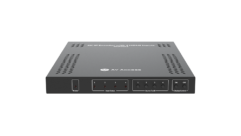Campus Security, Part 1: IP-based AV Tech Supports Campus Security Initiatives
Oct 3, 2007 12:00 PM,
By Linda Seid Frembes
Campus security has become a hot topic in the education market ever since the Virginia Tech shootings earlier this year. Both large and small educational institutions either added to or created new emergency response plans, with AV technology playing a major role. “Even prior to the Virginia Tech incident, educational facilities were looking to upgrade their old analog communication systems to newer technology. They started looking at IP-based technology as a means to deploy two-way communication quickly and cost-effectively,” says Chris Coffin, CEO of Digital Acoustics, a manufacturer of IP intercom and paging solutions in Lake Forest, Ill. “Since Virginia Tech, there has been a ramp-up in using technology that can be rapidly deployed.”
According to Coffin, Digital Acoustics began by selling products into the security market and eventually branched out to other market segments. The company specializes in IP intercoms and IP paging solutions, and it got involved in education sector due to the general need to replace old and aging infrastructure. “With the growth of networking in educational institutions, the ability to use IP-based products and deploy them very quickly was an important feature of our products in the educational environment,” Coffin says.
And as for campus security applications? “Our products have all the inherent characteristics of fast response. Additionally, we can provide location identification—where the call is coming from on campus—as well as the ability to record the audio in order to capture the distress call,” he says. “Using a paging system is very efficient. There is nothing like pushing a button and talking to someone right away. A classroom can be one button away from human assistance. “
For a school’s technology staff, the level of communication is just as easy and straightforward. “When the system is set up, you design the system to give each location a ‘friendly’ name, like ‘Mrs. Baker’s class.’ When the call comes in and shows up on the computer screen, it says Mrs. Baker’s class is calling,” Coffin says.
Coffin also notes that the market’s first wake-up call resulted from the communication debacles related to the 9/11 attacks. “We became more aware that it takes more than a fire alarm to get people out of the building,” he says. “They may also need additional instruction to stay in the building or dorm, or to gather at a certain location. Someone instructing you over an intercom system on what to do is much more succinct and easier to digest in a stressful environment or event. There are all sorts of different threats that we are more aware of now, and that awareness didn’t just happen in the municipal and corporate spaces; that happened in the educational spaces as well.”
Schools have invested in various forms of communication: sirens, audible warning tones, emergency PA systems, and telephones in the classroom. “The phone serves one form of communication, but an intercom gives you one-button instant access whether for campus security, tech support, or a medical emergency. The technology is faster and more accessible than the phone,” Coffin says.
The biggest benefit is that smaller colleges and individual school districts can also use IP-based communication technology. Given that the cost to install IP infrastructure was likely amortized years earlier, deploying an IP-based communication system such as one from Digital Acoustics is not cost-prohibitive. “There are few rooms that don’t have Internet provisioning,” Coffin says. “If you have Internet connectivity, then you have the ability to deploy our technology. There are even instances of schools using rolling AV carts with an intercom on it. Once it is hooked up to the network, the user can talk to the help desk.”
Other benefits of IP communication include:
- Can be used for daily messaging, tech support or for emergencies only
- Boundless; install anywhere and everywhere
- State-of-the-art, 100% IP & 100% digital
- LAN/WAN/Wireless implementations
- Integrates with mission-critical applications
- Easily addresses changing organizational needs
Coffin says he believes that AV/IT convergence will provide greater cost efficiencies and opportunities for schools. “Convergence will address the ongoing trend of multiple types of message delivery; it’s not just audio communication anymore,” he says. “Now there is email, SMS text, and digital signage coupled with increased connectivity with TCP/IP [with wires, wireless, or fiber]. That connectivity is the common backbone for each technology to talk to one another.”
In the next “AV in Education” newsletter (click here), we will highlight the University of North Carolina-Charlotte (UNCC). UNCC deployed IP-based paging and intercom systems for classroom tech support, but it also has added the system to its campus-wide emergency response plan.










